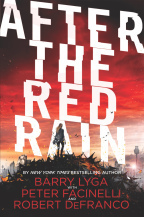Barry Lyga's Blog: The BLog, page 37
January 22, 2015
And Now I Have a Podcast
 You’d think writing a bunch of words and raising a teeny, tiny daughter who looks like Tintin and traveling around to talk about my books and playing Xbox and occasionally seeing friends would be enough for me.
You’d think writing a bunch of words and raising a teeny, tiny daughter who looks like Tintin and traveling around to talk about my books and playing Xbox and occasionally seeing friends would be enough for me.
You’d think that.
You’d be wrong.
Because, yes, now I have a podcast, too.
It’s called “Writing in Real Life” (WiRL!) and my co-host is my wife, Morgan Baden, who — in addition to having performed the admirable task of delivering Lygaspawn into this plane of existence — also happens to be a bestselling ghostwriter and a publishing communications executive.
We’ll be talking about writing, parenthood, marriage, and publishing, both individually and as intersecting aspects of our lives.
Check out the show. Subscribe in your favorite podcast client or in iTunes (or both!). Give it a listen and be sure to hit us up with email or on Twitter. Tell us what you’d like to hear us talk about! We can’t wait to hear from you!
January 19, 2015
Writing Advice #51: Revision Strategy
Confession time: I hate revising. Loathe it. Would like to stab it through the eye with a barbecue fork until it’s dead. Ask any of my editors — they will tell you that getting Lyga to commit to a revision is like pulling teeth. Your own teeth, that is.
I know authors who effusively praise the revision process, who say things like, “Revising is where the real writing happens!” Or “I don’t know the story for real until I start revising.”
Me? I’m the guy who once said on a panel, “If you have to revise, it means you fucked up in the first place.”
So, yeah. Not a fan of revision, am I.
Which is not to say that I don’t need to revise. I don’t mean to imply that my first draft is some kind of literary Immaculate Conception. From conversations with other authors, I sort of get the impression that my first drafts are a bit sturdier and cleaner than most, but that doesn’t mean there are no improvements to be made.
I just hate doing them.
I love getting that story out, and when it’s over, I experience an emotional rush. It’s like eating a great meal and getting up from the table, perfectly satisfied.
Revising, to me, is like then being forced to throw up that meal, reassemble it from the vomitus, and eat it again.
Are you getting the drift? I really, really, really don’t like–
Oh, you did get the drift. Good.
Anyway, among the many authorial questions I get, revision always ranks fairly high. Usually, I have nothing to say because I feel like I’m a terrible reviser and therefore I have nothing to contribute.
But right now, I’m revising a project that I hope to be able to tell you about soon. And I realized that revising for me works best when there’s some kind of structure to it.
Not structure to the piece being revised, mind you — structure imposed on the process of revising in and of itself.
Over the past few years, I’ve sort of stumbled upon a revision method that works for me. It makes the process marginally less painful because it turns it into a sort of puzzle. So instead of bemoaning the fact that I’m revising something that I should have gotten right in the first place if I didn’t suck, I’m instead assembling pieces in the correct order.
I can’t say that this is a particularly sensible way to revise, or that it will work for you. I can’t even say that it’s the best way for me to revise. For all I know, I’m actually making it harder on myself or missing out on a lot of opportunities.
What I do know is this: I’ve used this method on five or six books at this point, which is much longer than I’ve used any other method. And I guess that has to mean something.
So, with no further ado, here you go:
Step One: Assemble your notes.
If you’re revising, then you probably have a goal in mind. You probably have comments from beta readers and/or an editor to take into account. And you probably have some thoughts of your own that have bubbled to surface in the time since you finished the first draft of the manuscript.
I take all of those thoughts, notions, notes, criticisms, questions, and comments, and I assemble them into a single document. I don’t necessarily impose any sort of order on this document, so long as it’s very obvious where one thought ends and another one begins. (Seriously — a blank line between them will suffice. No need to set up a formal structure.)
Step Two: Label your notes.
Then I print out the document, however long it happens to be. Sometimes it’s a couple of pages. In the case of one book, it was nearly twenty pages long. Whatevs.
At the top of each page, I put a sequential letter. In other words, the first page is A, the second is B, etc. If I got to Z, smart-ass, I’d move on to AA, but that’s never happened.
Step Three: Read the F*%^*&ing Book!
You’d think this would be obvious, but I’m sure someone out there has tried revising without actually reading the book. But hey, look — you gotta read it! As you do so, you’re going to do two things:
First of all, you’re going to note on the manuscript itself any goofs or hiccups. Word choice, tortured sentence logic, what-have-you. Just like the good copyeditor you’re pretending to be.
Second of all, though, is the magic. As you read, stop reading at the end of each chapter and switch over to your pile of notes. Skim through to see which notes — if any — apply to the chapter you just read. Then go back to the manuscript and find the page(s) in the chapter that should receive the goodness of the note. Mark the letter of the note page on the manuscript page where you plan to implement it, close to where on that page you’ll implement it, too. Then put the manuscript page number on the note page, next to the note.
This is what a manuscript page and note page from my current work in progress look like. (Apologies for all of the blur, but…spoilers!)
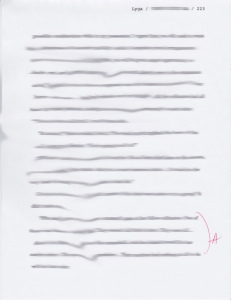
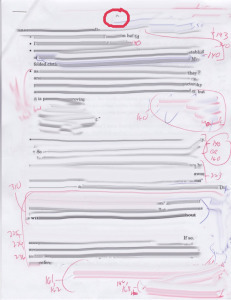
Go on, blow ‘em up. The first image is a page from the manuscript. You can see that I’ve written “A” and bracketed the last paragraph. When we go to the next image, we see that it’s note page A. And somewhere on there, you’ll find page 223 written next to a note in the modern cuneiform I call my handwriting.
Step Four: Go through the Manuscript
Once I’m done reading and noting, I just page through the manuscript, looking for my corrections and for my letters. When I run across a letter, I cross-index to the proper note on the proper page and implement the revision/fix.
See? Easy!
One great thing about my method (if I do say so myself) is that the randomness and repetition reinforce the changes. What I mean by that is this: Since I don’t impose any sort of order on my notes (and you’ll see that I also add some in pen as I go along), I’m forced at the end of each chapter to skim through the entire notes document. This means that I’m constantly reading the notes, imprinting them on my brain, so that even when I’m not focusing on them, I’m subconsciously working on them as I read the manuscript itself.
Maybe you’re one of those monstrous literary goblins who actually enjoys revising. (In which case, why did you read this at all?) But if you’re at all like me and find revising to be tedious, painful, and jaw-clenchingly anxious, give this system a try. I hope it helps you!
header image courtesy Nic McPhee via Creative Commons
January 16, 2015
Tales of Incompetence: Hertz
Unlike my epic battle with UPS, this one is pretty short. But no less frustrating.
A few weeks ago, I rented a car from Hertz. I was charged a little over thirty dollars as a fuel surcharge and told that if I returned the car with the same amount of fuel I’d taken it with, I would be refunded that money. Sounded good to me — I wouldn’t have to worry about topping off the tank (always a pain the butt in New York City).
I took the car from the location with half a tank of gas. And a few days later, I returned it with half a tank. Great!
They were swamped, so the guy asked he could email my receipt. No problem; less paper for me to handle.
Well, the receipt never came and it was New Year’s, so I forgot about it (as you do). A couple of weeks later, I noticed the charge had come through on my credit card statement…and the fuel surcharge was still there. I called the local office to have the charge removed and was told that their systems were down…and had been for days. My only option was to call the national billing department.
I called the billing department and explained the issue, expecting them to say, “Oh, yes, we’re sorry for the oversight. I’ll email you a receipt immediately and also remove that charge.”
Instead, I was told that I would have to provide a receipt for my fuel purchase. To prove I’d brought the car back with gas.
I explained that Hertz already knew that I had taken the car with half a tank of gas and had then checked it back in with half a tank. Part of the check-out process is confirming mileage and gas. Part of the check-in process is confirming the change in the same. If you’ve ever rented a car before, you’ve witnessed this. It’s Car Rental 101. Hertz knew — they had a record — that I’d taken and returned the car with the same amount of gas. Why did they need a receipt?
“You have to send us a receipt,” the woman on the phone insisted.
Thinking I must be having some kind of communication issue, I asked to speak to a supervisor. But she, too, insisted that I send a receipt.
Well, I had returned the car weeks before. I didn’t have the receipt any more. How long do you keep a receipt from a gas station?
The supervisor told me I could send along a credit card statement showing gas purchased “on the day you returned the car.”
This seemed even more idiotic to me! For all she knows, I could have bought gas the day I returned the car and returned it to Hertz with the tank bone-dry! The proof Hertz needed is in its own records, that I returned the car with half a tank of gas.
But no amount of explaining would budge her. It was proof I’d bought gas that day (not proof I’d actually put in the car, mind you, like, say, Hertz’s check-in record), or nothing.
She read out to me a ridiculously complicated email address to send a scan of my credit card statement. I sent the scan off and heard nothing back. A couple of days later, though, the charge was reversed on my credit card, so that’s nice.
Basically, then, everyone can rent Hertz cars, pay the fuel surcharge, buy gas the last day you have the car, but return the car with the tank empty. Then call Hertz’s national billing department and insist that you are due a refund. When they ask for proof, send them a receipt from a gas station.
Instant free gas, courtesy of Hertz’s corporate idiocy.
Morons.
January 15, 2015
Commercial Stupidity: KFC
For a brief moment, I planned on running a regular BLog feature in which I would excoriate dumb commercials. But I realized that life is short and my ire is long and I have better things to do with my time.
And then I saw the commercial below and I just had to say something.
Now, look, I love me some fried chicken. I am a fried chicken fiend. Especially with some mashed potatoes and gravy. And maybe a nice piece of warm, homemade corn bread. And a little side dish of creamy macaroni and cheese. And–
Wait, what? What was I saying? Oh, right — this commercial.
This stupid, stupid commercial.
So, what KFC seems to be telling us is this: If you keep eating pre-prepared chicken all the time, you’re lame! Come eat our pre-prepared chicken!
Uh, what?
Let me get this straight: The solution to eating the same thing over and over is to…eat…the…same…thing…
Out of a different container?
And in a form that is enormously less healthy?
Say what you want about rotisserie chicken — it’s better for you than fried, no matter how much you (and I!) may love fried. Hell, the market near me makes an incredible adobo rotisserie chicken that I would probably sell a major organ for.
KFC isn’t saying, “Hey, stop eating burgers all the time and try some of the Colonel’s wholesome fried goodness!”
It’s not saying, “Cooking is tough every night — take it easy with a bucket of savory, crunchy, chicken-y delight!”
No. Through this ad, KFC is saying that it’s lame to eat the same thing all the time and that the solution to eating spit-roasted chicken is to eat fried chicken.
Is it just me, or is that sort of…stupid?
January 13, 2015
For the Tech of It: Clips
 Last year, I wrote about my various writing tech choices. Since then, I’ve made some adjustments/changes/upgrades, so For the Tech of It returns to fill you in!
Last year, I wrote about my various writing tech choices. Since then, I’ve made some adjustments/changes/upgrades, so For the Tech of It returns to fill you in!
Today, I want to talk about Clips, a really terrific app that goes a long way towards bridging an important gap in the iOS universe.
(Note: Clips works beautifully on both iPad and iPhone. My screenshots are from the iPad.)
One of the puzzling flaws of both the Mac and iOS is the clipboard’s inability to store more than a single copied/cut item. I’m sure you’ve all experienced the horror of cutting something important, then accidentally cutting something else before you pasted, thereby eliminating the original cut material from this particular quantum incarnation of the universe.
(In fact, I have a quite famous author friend who once cut an entire chapter, preparatory to moving it elsewhere in the document…and then goofed and copied a sentence from elsewhere. Oops. Chapter gone.)
If the clipboard could maintain more than a single item, this wouldn’t be a problem, but Apple has yet to see fit to incorporate this functionality.
On the Mac, I use a little app called CopyLess Lite, which stores my ten most recent copied/cut items. (You can upgrade to CopyLess for $4.99 and have 100 items, if you like.). CopyLess just runs in the background, jacked into the system clipboard, and intercepts whatever heads its way.
But on iOS, there’s no way to do such a thing.
Until now.
The clever folks at Clean Shaven Apps have come up with a workaround. It’s not quite as dead simple as CopyLess, but that’s not their fault.
Introducing… Clips.
Basically, Clips works like so: You copy or cut from any app as usual. Then, you quickly swipe down the Notification Center. In the Today view, you’ll see a section for Clips, showing whatever you just copied or cut in a dotted-line box.
To keep that material forever (or until you decide to discard it), simply tap it. The dotted line becomes solid. You can now return to your app.

The Clips widget. (Click to enlarge.)
It’s really that easy. For every bit of copied or cut material you want to keep, you just swipe down the Notification Center and tap on it. Now it’s stored in Clips for your use.1
If you find yourself wanting to paste in some text that you copied, say, ten copies back, just find that text in the widget and tap on it. Boom shakalaka! It is now placed on the clipboard and you can paste into any app.
Awesome.
Just about anyone could occasionally benefit from using Clips, but for writers, it’s particularly useful. Grabbing a bunch of research blurbs from a web page and don’t want to have to constantly switch between your browser and your research document? No problem. Moving around lots of text to different places in your current manuscript? You’re covered.
When you’re done with an item, you can leave it in Clips or delete it right from the widget. Rarely do you even need to open the Clips app.
Clips even has its own keyboard! Why do you need a clipboard keyboard, you ask? Well, check it out:
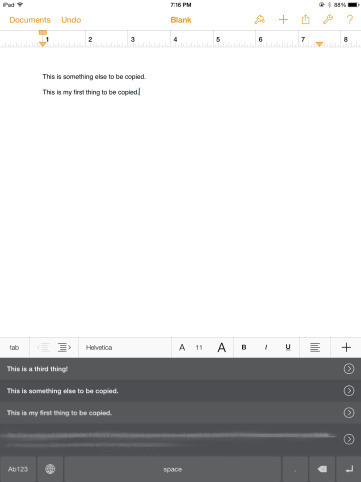
The Clips keyboard.
That’s right: The “keyboard” (invoked by pressing the little globe on the standard iOS keyboard) is really a scrolling list of everything you’ve stored in Clips. Need to paste in ten things quickly? Just switch over to the Clips keyboard and tap-tap-tap!2
Here’s some info from the developers:
Clips is free to download and use on your iPhone and iPad.
There are no limits for the first week of your use. After which, you can only save 5 clips.
If you find Clips useful, you can purchase an upgrade in-app to unlock unlimited clips and syncing between all your iOS devices.
You really can’t lose. Try Clips for free and see how easy it is. It will transform the way you work on your iOS device. I’ll wager you will, like me, find yourself paying the mere $1.99 (only a buck ninety-nine!) to upgrade to the full, unlimited version.
Clips is more than just storage, BTW. It also has some cool shortcuts for formatting your text, especially text grabbed from web pages.Followed, of course, by seven more taps.
January 9, 2015
After the Red Rain: Preorder it Now!
After the Red Rain, my collaboration with Peter Facinelli and Rob DeFranco, hits shelves on August 5, 2015. But you can preorder it now.
A postapocalyptic novel with a cinematic twist from New York Times bestseller Barry Lyga, actor Peter Facinelli, and producer Robert DeFranco.
On the ruined planet Earth, where 50 billion people are confined to megacities and resources are scarce, Deedra has been handed a bleak and mundane existence by the Magistrate she works so hard for. But one day she comes across a beautiful boy named Rose struggling to cross the river–a boy with a secretive past and special abilities, who is somehow able to find comfort and life from their dying planet.
But just as the two form a bond, it is quickly torn apart after the Magistrate’s son is murdered and Rose becomes the prime suspect. Little do Deedra and Rose know how much their relationship will affect the fate of everyone who lives on the planet.
Preorder from the usual places:
Amazon
Barnes & Noble
Kobo
iBooks
January 1, 2015
2014: The BLog in Review
So, WordPress now offers some terrific site stats and even prepares a year-end report for you, with no prompting. So I figured I would share some of the highlights from 2014 for Barry Lyga Dot Com.
Apparently, December 3 was the busiest day of the year for this site. I have no idea why. Did something weird or amazing happen that day? Strangely enough, the most-visited page that day was…my bio page.
My longest update streak was in July, when posted to the BLog five days in a row. I feel kinda bad about that, actually. I’d like to update more often and more consistently. I just don’t always have things to say, and sometimes dastardly Real Life gets in the way.
Tuesday, for reasons I will never understand, was the day I was most likely to blog. If you know why, you’re one-up on me!
The most-visited page of the year was the announcement of Blood of My Blood and Lucky Day. This surprises me not even a little bit.
The top referring site for the year was Twitter. So, yeah, I guess I’m keeping that Twitter account! Also in the Top Five referrers was my Tumblr page, which gratifies me greatly. I came late to Tumblr, but I really like it, so I’m glad people are finding me there and then visiting me here, too.
Also on the Top Five, interestingly, was the old Fanboy & Goth Girl website. I truly didn’t think anyone went there any more.
Visitors were mostly from the United States (not a big surprise, as most of my readership is in the U.S.), but the site received visitors from 125 other countries. I honestly didn’t realize my mom traveled so much.
December 31, 2014
Recommended Reading 2014
Every year, I curate my list of read books to present to you a few that I think truly stand out and are worthy of your time and energy…to say nothing of your hard-earned bucks! This year, I heartily recommend you read:
Wise Blood by Flannery O’Connor
The Orange Houses by Paul Griffin
The Last Policeman by Ben Winters
Dark Places by Gillian Flynn
I Am the Mission by Allen Zadoff
The Scatter Here Is Too Great by Bilal Tanweer
Joyland by Stephen King
Learning to Sleep
Given that I’m an idiot — and a self-absorbed one, at that — it probably comes as no surprise to you to learn that of the myriad things I did not know about babies until I became a father is this: Babies don’t know how to sleep.
More accurately, babies know how to sleep, but they don’t know when to do so or how to fall asleep. I was stunned to watch my daughter — clearly exhausted beyond belief — fight sleep with all her might,1 despite her very obvious, very desperate need for some shut-eye. Babies, I learned, have no clue how to fall asleep. It is the job of their parents to teach them.
Now, it is family lore that I — quite infamously — never slept as a baby. So at least Leia comes by her insomnia honestly. My father, to hear him tell it, did not sleep a wink during the last Nixon Administration, spending his late nights rocking me in a cradle, keeping himself awake by watching old reruns of Perry Mason.2
And so, maybe I should have been prepared for Leia’s epic Battle with Sleep. Beginning partway through week three of her time on earth, she settled on a staunch anti-sleep platform, with no flip-flopping. Desperate times called for increasingly desperate measures, and her sleep-deprived mom and I tried everything we could think of. In what is surely a cruel joke of evolution, babies don’t know how to fall asleep as soon as three weeks…but you can’t teach them how until around eight weeks. Meaning you have four or five delightful weeks of, well, the 21st century equivalent of Perry Mason reruns. (In my case, listening to geeky podcasts. In my wife’s, Serial and Vanderpump Rules.)
But at Leia’s eight-week check-up, our pediatrician gave us the go-ahead to begin the dark art of sleep training, which process involves ritual sacrifice, a purification rite, some kind of pseudo-Catholic baptism, and — in extreme circumstances — invocation of the spirit of Neil Gaiman, just in case.
We performed the rituals as prescribed and — just a few days before the New Year — began sleep training Leia.
And let me tell you — it sucked. Not as badly as for some (I’ve heard of kids screaming for three hours before finally succumbing to Morpheus’s sweet, sweet embrace), but when it’s your kid, even a minute of crying is roughly 59 seconds too much.
Still, two days in, and Leia is taking to sleep quite well. She’s still nap-challenged, but whereas on Night One, she wailed for well over half an hour before falling asleep, on Night Two she cried for a mere fifteen minutes. If the trend continues, she’ll be sleeping with relative ease in a couple of days, and then we can figure out how to get her to nap.
All of this sleep talk has made me come face-to-face with my own sleep issues. I wish I could say I’m a better sleeper today than the days of my dad and Raymond Burr keeping me company into the wee hours, but the truth is this: sleep and I have always been wary of each other.
I’ve had trouble falling asleep as long as I can remember. When I was younger, I would try to relax by creating stories in my head as I lay in bed. This proved counter-productive — the stories would only pique my interest and I would lay there all night long, revising and editing in my head so that I could transcribe the results the next day. A tactic devised to combat my insomnia only made it worse.3 I estimate that through my adolescence and teen years, I probably slept no more than four hours a night on average.
Strangely enough, in college — that time of life when sleep seems fleeting and less important than drinking, hooking up, and occasionally studying — my sleep actually improved. I had programmed myself to be a night-owl, even though the rest of the world (read: school) demanded I waken early in the morning. In college, though, I could tweak my own schedule. Even though I was still tossing and turning into the wee hours, I didn’t have to rise until much later.
After college, it was back to the harsh taskmaster of a “real world” schedule, and I once again got less and less sleep as time wore on. And then I started writing full-time and my life became my own. I made my own schedule and could sleep as late in the day as I wished. It was — no lie — pretty great. I was finally getting as much sleep as I wanted.
But all good things must come to an end. It’s one thing to stay up until two or three in the morning and sleep until ten when you’re single and have no responsibilities other than book deadlines.4 It’s quite another, though, when you’re a husband or a father. Or both. Simply put: It ain’t cool to be sleeping until noon as your wife handles a newborn by herself.
But the damnable part of it is… I’m also no good to anyone before noon because I’m zonked from lack of sleep. I still don’t know how to fall asleep, and unlike Leia, I can’t fall back on the whole “I was just born a little while ago and I’m still figuring this out” excuse. I can’t keep crawling into bed at eleven every night, then laying awake until two, no matter how exhausted I am.
Babies can get away with it. They’re basically stupid, when you get right down to it. I’m not supposed to be. It’s OK to have to teach Leia how to sleep, and that’s exactly what my wife and I are doing.
Now I just have to figure out how to teach myself.
Peaceful Sleep photo © 2008 Christopher Meredith. Used under Creative Commons 4.0.
And she has a considerable amount of might.This was ancient times, people — no Netflix. No DVDs. Hell, no cable!But I credit that same tactic with my developing writing skills. My loss is your gain. You’re welcome.Editors don’t care at what hours books are written, after all.
December 30, 2014
Horn Book Reviews Lucky Day
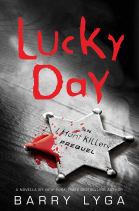 Way back in September, The Horn Book reviewed Lucky Day. Somehow, I missed this!
Way back in September, The Horn Book reviewed Lucky Day. Somehow, I missed this!
Appropriately, given its adult protagonist, the tone of this prequel is very different from the novels’. Instead of Jazz’s teenage first-person narrative, here a partially omniscient third-person narrator relates G. William’s (very mature) concerns and experiences.
Check out the complete review here.
The BLog
- Barry Lyga's profile
- 2185 followers



